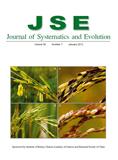Xiao-Hua JIN, De-Zhu LI, Xiao-Guo XIANG, Yang-Jun LAI, Xiao-Chun SHI
The phylogenetic positions of the enigmatic “wildcard” taxon, Habenaria griffithii, were inferred from molecular data and morphological evidence. Morphologically, H. griffithii is quite “isolated” in Habenaria; instead, it is close to Gennaria, Diphylax, Peristylus, and Platanthera. It can be distinguished from these four genera by its slender staminodes conspicuously longer than the anther, rostellum having two relatively long arms, lip and lateral sepals connate in the basal part, and a transverse cushion-shaped stigma. An analysis of combined plastid and nuclear data (rbcL, matK, and internal transcribed spacer) using Bayesian and parsimony methods revealed that H. griffithii is closest to Gennaria, a monotypic genus restricted to the western Mediterranean and Canary Islands. On this basis, a new genus, Nujiangia, is tentatively proposed to accommodate this taxon. In addition to the taxonomic treatment of this genus, the delimitation of many related genera in Orchideae is discussed.

